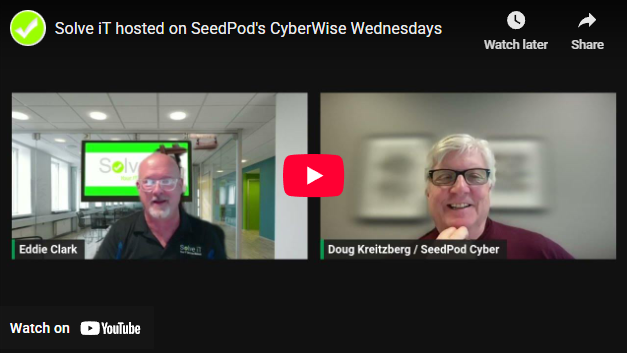What Small Businesses Miss About Cybersecurity Insurance: Eddie Clark on CyberWise Wednesdays

There is a big difference between cyber insurance and cybersecurity strategy. Yet too many small and mid-sized businesses treat it like a shield. They check a few boxes on an application and assume they’re covered. Then a breach hits, and find their claim is denied because of something as basic as incomplete multi-factor authentication. They lose thousands of dollars and their safety net.
This came up in a recent episode of CyberWise Wednesdays, where I sat down with Doug Kreitzberg of SeedPod Cyber. We talked about why SMBs remain such vulnerable targets and what it actually takes to be secure and insurable.
The Wake-Up Call: What Insurance Carriers Are Looking for BEFORE They Insure Your Business
Cyber insurance used to be a one-page form. Now it’s a deep audit. Carriers want to see technical controls in place, yes, but more importantly, they want proof that your business has robust processes and governance. They’re asking questions like:
-
Do you have an incident response plan?
-
Are your backups tested and segmented?
-
Do you enforce MFA across all users, including the C-suite?
It’s not enough to have the right tools. You need policy, enforcement, and a consistent way to show how you manage risk.
Putting Your Risk in Terms of Dollars to Help Make Decisions
One thing that changes the game for our clients is when we show them what their data is worth on the black market. We don’t just say, "You could be at risk." We translate that risk into dollars. This gets everyone’s attention, from IT managers to CEOs. When a business owner sees how much a breach could actually cost, conversations start to shift.
People and Process Matter Just as Much as Tech
Too often, companies focus entirely on the tech stack. Firewalls, antivirus, and email filters. But the real weak link? People and processes. That’s where most business email compromise cases start.
For example, if your accounting team receives an email that appears to be from the CEO requesting a wire transfer, do they have a process in place to verify its authenticity? If not, you’re exposed. That exposure might not be covered by insurance if your policies are nonexistent or ignored.
Test the Plan Before You Need It
We coach clients to run tabletop exercises before a breach ever happens. You can pull out your incident response plan and walk through it with your execs, HR, and IT. Don’t wait until you’re locked out to realize your backup failed, or that no one knows who to call.
We also ensure that our clients are protected with our own Breach Protection Warranty, which covers up to $1 million in response expenses, including ransomware support, forensic investigation, and legal assistance. But even that only works if the basics are in place.
How to Get Started
If you’re a small business trying to figure out where to start, we published a free guide that shows you how to build your cybersecurity program from scratch. It covers everything from selecting a framework, such as CIS, to aligning your tools, policies, and insurance.
And if you'd like, you can book a free threat assessment with our team. We’ll provide you with a clear view of your risks, show you what it would cost to do nothing, and outline a path to achieve security and insurability.
SolveiT helps small businesses sleep at night by monitoring, maintaining, and securing their IT systems 24/7. We deliver peace of mind through proactive support, clear communication, and no shortcuts.

